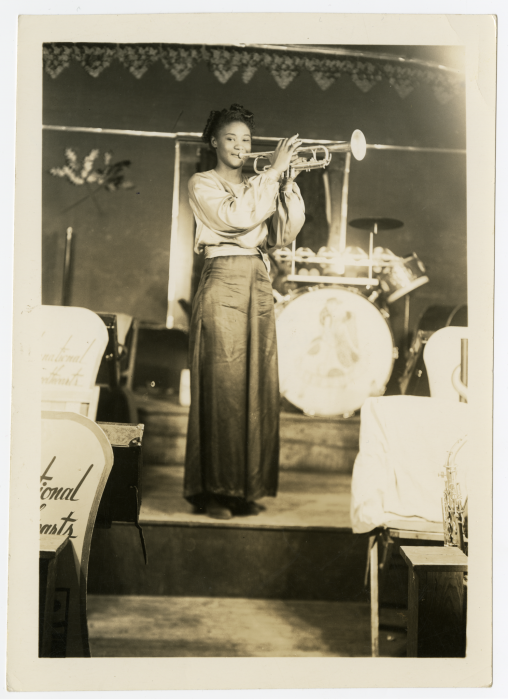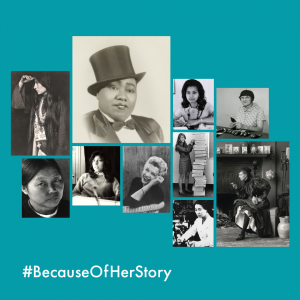#BecauseOfHerStory: Meredith Holgrem
Curator Meredith Holmgren Elevates American Women in Music
Meredith Holmgren works as the curator of American women’s music at the Smithsonian Center for Folklife and Cultural Heritage. Sara Cohen spoke with her about her work and some of her favorite lesser-known stories of how women have changed American music.
What kinds of projects do you work on as the curator of American women’s music?

Meredith Holmgren holds a Peggy Seeger record from the Ralph Rinzler Folklife Archives. (Photo courtesy of Meredith Holmgren)
I tell stories about women and music through art, objects, recordings, public programs, and digital resources. My job is to examine and elevate women’s contributions to the American musical landscape.
Recently, I’ve been working with Smithsonian library collections to identify histories of underrepresented women music professionals. I’m currently working on an exhibition with Smithsonian Libraries about women and the music of social change. The exhibition explores how women have shaped our relationship with music and influenced historical events. Women in music impact our society as caretakers, educators, activists, performers, and businesspeople. I’m excited to bring some of those stories forward for public audiences with the Smithsonian Libraries team.
What’s one Smithsonian women’s object you that moves you?
I have really enjoyed learning about the National Museum of American History’s “International Sweethearts of Rhythm” collection. It’s dedicated to the first racially integrated, all-women big band jazz group in the United States. The band was originally founded in the 1930s to raise money for the Piney Woods School, a historically Black boarding school in Mississippi. But the band eventually branched out independently and became a national sensation. Some of the best women jazz instrumentalists of the day went on to join their group.

Piney Woods School, International Sweethearts of Rhythm Collection. National Museum of American History, Archives Center.
What’s the best thing about your job?
I really enjoy learning about all the wonderful collections we have in different museums and collections at the Smithsonian. The Smithsonian has musician portraits on stamps in the National Postal Museum, sheet music at the National Museum of American History, instrument collections at the National Museum of Natural History, and sound recordings at the nonprofit record label Smithsonian Folkways Recordings. In all, we have a stunning variety of musical resources, art, and artifacts. In fact, if you were to combine all the Smithsonian’s musical resources into one museum, we speculate that it would comprise the largest music museum in the world. Working with such rich collections, and the dedicated coworkers who help care for them, is a real honor.
What would you say to a middle school student interested in learning more about music and women’s history?
Music is a powerful vehicle for understanding humanity. It can help us tell stories, express our feelings, convey cultural values, celebrate milestones, comfort our pain, and improve our quality of life.
Women have made, and continue to make, incredible contributions to American music. Yet when you listen to popular radio, women represent only 14% of songwriters, 22% of artists, and 2.6% of producers played, according to the University of Southern California Annenberg Inclusion Initiative. By shining a spotlight on women in music, we tell a more complete story about American music.
I recommend that people start by investigating what resources exist in their own towns. Look for performance centers, museums, libraries, and other organizations that work with local music and women’s history. You can also search for great online resources. At the Smithsonian, you can browse some of our collections on our Learning Lab to read more about both women’s history and music history.
What’s one lesser-known women’s history story that you wish more people knew?
Did you know that the first rap single was produced by a woman? Much like film directors, producers direct the development and process of creating music like albums, singles, and soundtracks. Sylvia Robinson, founder and chief executive officer of Sugar Hill Records, made hip hop history when she produced the hit single “Rapper’s Delight” in 1979. Even before becoming a record label owner, she had a multi-decade career as a professional music artist. Robinson’s talent, drive, and business savvy helped define one of the world’s most successful music genres. Hip hop wouldn’t exist as we know it today without her.
 The Smithsonian American Women’s History Initiative, Because of Her Story, funds curators to research and share women’s history at museums and centers across the Smithsonian.
The Smithsonian American Women’s History Initiative, Because of Her Story, funds curators to research and share women’s history at museums and centers across the Smithsonian.
Posted: 21 September 2020
- Categories:








